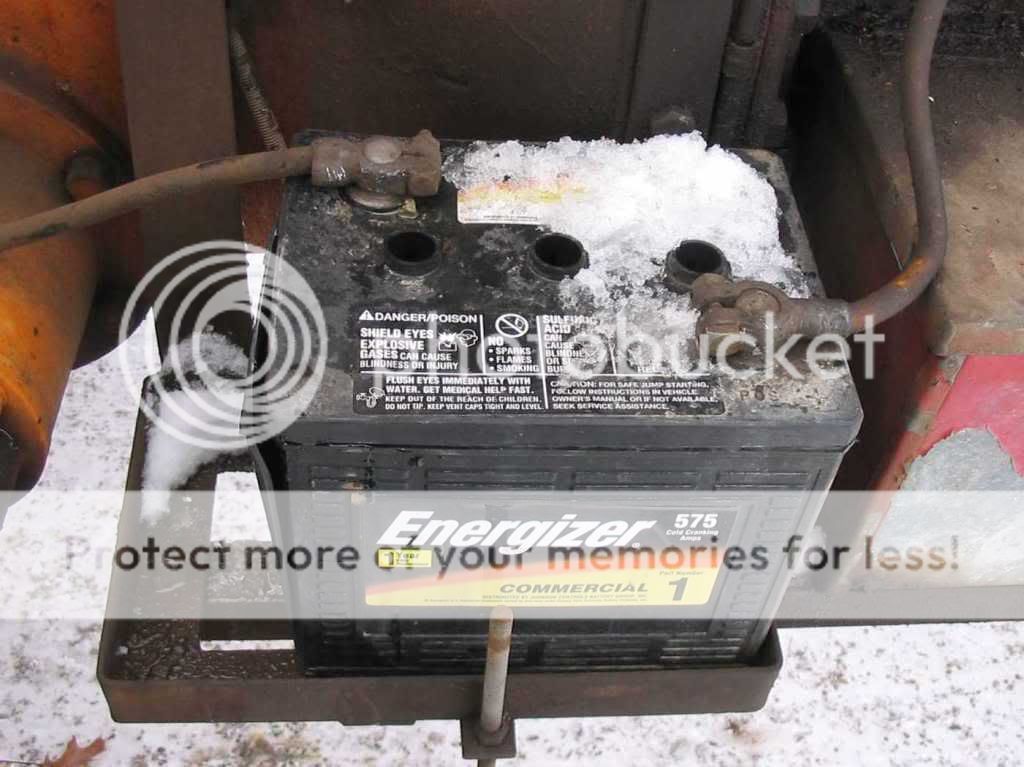Bob M
Well-known Member
Hey John T -
Your advice that 3 ohms is the correct resistance for a cutout system "low charge" resistor for my Minnie Mo U was right on!
I found a 3 ohm, 20 watt resistor in my electrical junk box, temporarily wired it to the charge switch and it worked great. Found it limited the "low" charge rate to about 4 amps at governed RPM - exactly what I wanted.
----
However I ran into another problem: I started the tractor early Sat morning then left it to warm up. While warming the charge switch was set to "high" and the ammeter indicated about 10 amps. After warming 15 minutes or so, I reset the charge control switch to "low" and put the tractor to work.
I ran the tractor for perhaps an hour before noticing all (3) battery caps were missing. (They'd been in place when I first started it up.) Upon closer inspection I discovered the battery top was cracked around its entire perimeter. Also one end of the battery was split all the way to the bottom (photo) and there was no electrolyte visible in the end cell.
It appeared the battery had suffered an internal explosion while the tractor was warming up unattended. (I'm sure I'd have seen/heard if it let go while I was aboard!)
The battery is just over one year old. On "high charge" the charging system is only good for about 15 amps cold (it tapers to around 12 amps as the generator warms up). So it's not like the battery had been grossly overcharged.
Any ideas what might have caused the failure???
----
More curiousity: The Minnie ran fine all day with the split battery - I didn't dare shut it off. All day the ammeter indicated a 3 - 4 amp charge at governed RPM. Then despite overnite temps in the low teens, the tractor started unassisted and ran fine another 8 hours the following day with the split battery. Go figure(!)
...Bob M

Your advice that 3 ohms is the correct resistance for a cutout system "low charge" resistor for my Minnie Mo U was right on!
I found a 3 ohm, 20 watt resistor in my electrical junk box, temporarily wired it to the charge switch and it worked great. Found it limited the "low" charge rate to about 4 amps at governed RPM - exactly what I wanted.
----
However I ran into another problem: I started the tractor early Sat morning then left it to warm up. While warming the charge switch was set to "high" and the ammeter indicated about 10 amps. After warming 15 minutes or so, I reset the charge control switch to "low" and put the tractor to work.
I ran the tractor for perhaps an hour before noticing all (3) battery caps were missing. (They'd been in place when I first started it up.) Upon closer inspection I discovered the battery top was cracked around its entire perimeter. Also one end of the battery was split all the way to the bottom (photo) and there was no electrolyte visible in the end cell.
It appeared the battery had suffered an internal explosion while the tractor was warming up unattended. (I'm sure I'd have seen/heard if it let go while I was aboard!)
The battery is just over one year old. On "high charge" the charging system is only good for about 15 amps cold (it tapers to around 12 amps as the generator warms up). So it's not like the battery had been grossly overcharged.
Any ideas what might have caused the failure???
----
More curiousity: The Minnie ran fine all day with the split battery - I didn't dare shut it off. All day the ammeter indicated a 3 - 4 amp charge at governed RPM. Then despite overnite temps in the low teens, the tractor started unassisted and ran fine another 8 hours the following day with the split battery. Go figure(!)
...Bob M


